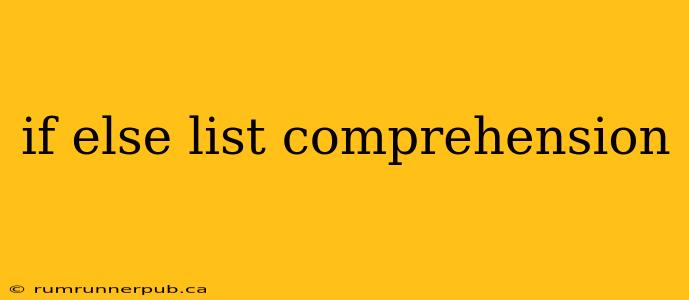List comprehensions are a powerful feature in Python, allowing you to create lists concisely. But their true power shines when combined with conditional logic using if and else statements. This article will explore how to effectively use if-else within list comprehensions, drawing on insights from Stack Overflow discussions to clarify common pitfalls and best practices.
The Basics: If-Only List Comprehensions
Before diving into if-else, let's review the simpler if-only case. This is the most common scenario, where you filter elements based on a condition.
numbers = [1, 2, 3, 4, 5, 6]
even_numbers = [num for num in numbers if num % 2 == 0] # Output: [2, 4, 6]
This comprehension iterates through numbers; if the number is even (num % 2 == 0), it's added to even_numbers. This is equivalent to:
even_numbers = []
for num in numbers:
if num % 2 == 0:
even_numbers.append(num)
But much more concise!
Tackling If-Else: Conditional Value Assignment
The real power emerges when we introduce else. This allows us to assign different values based on the condition. The syntax is slightly different from a standard if-else statement.
numbers = [1, 2, 3, 4, 5, 6]
even_odd_strings = ["Even" if num % 2 == 0 else "Odd" for num in numbers] # Output: ['Odd', 'Even', 'Odd', 'Even', 'Odd', 'Even']
Notice the placement of if and else. The if condition comes before the else, and the entire conditional expression precedes the for loop. This creates a ternary operator within the comprehension.
Stack Overflow Insight: Many Stack Overflow questions (e.g., similar to those tagged with python list-comprehension and conditional-logic) highlight the importance of this ordering. Incorrect placement often leads to SyntaxError exceptions.
Practical Examples: Beyond Simple Conditions
Let's explore more complex scenarios. Consider transforming a list of numerical grades into letter grades:
grades = [85, 92, 78, 65, 95]
letter_grades = ["A" if grade >= 90 else "B" if grade >= 80 else "C" if grade >= 70 else "F" for grade in grades]
# Output: ['B', 'A', 'C', 'F', 'A']
This demonstrates nested if-else conditions within the comprehension. While functional, it can become less readable with more complex logic. For intricate conditions, a separate function might improve clarity.
Adding Value: Function for Better Readability
For enhanced readability, especially with multiple conditions, consider a helper function:
def grade_to_letter(grade):
if grade >= 90:
return "A"
elif grade >= 80:
return "B"
elif grade >= 70:
return "C"
else:
return "F"
grades = [85, 92, 78, 65, 95]
letter_grades = [grade_to_letter(grade) for grade in grades] # Output: ['B', 'A', 'C', 'F', 'A']
This approach significantly improves readability and maintainability.
Conclusion
if-else in list comprehensions offers a powerful way to generate lists with conditional logic. While concise, complex conditions may benefit from separate functions to maintain code clarity. Remember the correct syntax and leverage Stack Overflow resources for troubleshooting common errors. By understanding and applying these techniques, you can write more efficient and readable Python code.
